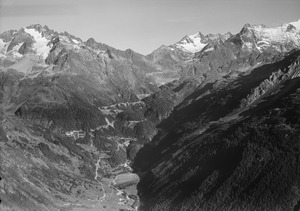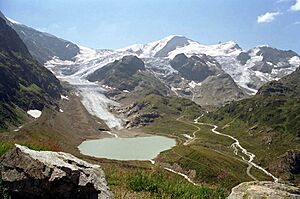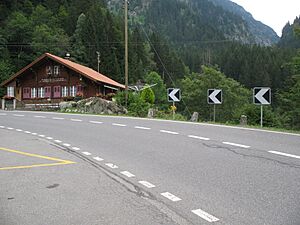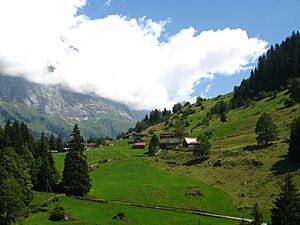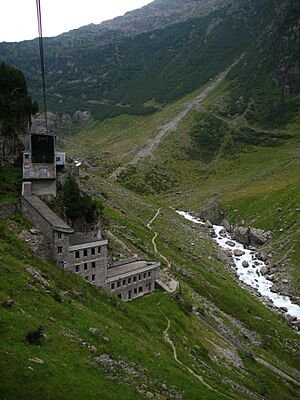Gadmen facts for kids
Quick facts for kids
Gadmen
|
||
|---|---|---|
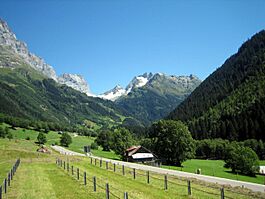
Valley of Gadmen
|
||
|
||
| Country | Switzerland | |
| Canton | Bern | |
| District | Interlaken-Oberhasli | |
| Area | ||
| • Total | 116.4 km2 (44.9 sq mi) | |
| Elevation | 1,205 m (3,953 ft) | |
| Population
(Dec 2011)
|
||
| • Total | 228 | |
| • Density | 1.959/km2 (5.073/sq mi) | |
| Postal code |
3863
|
|
| Surrounded by | Engelberg (OW), Göschenen (UR), Guttannen, Innertkirchen, Oberwald (VS), Wassen (UR) | |
| Twin towns | Volketswil (Switzerland) | |
Gadmen was a small village and a former town in the Interlaken-Oberhasli area in the canton of Bern, Switzerland.
On January 1, 2014, Gadmen joined with the town of Innertkirchen. The name Gadmen comes from an old German word, "gadum," which means "barn" or "small house." It was first mentioned in records in 1382. Gadmen also had a special partnership with the town of Volketswil in the Canton of Zürich.
Contents
History of Gadmen
During the Middle Ages, the Gadmen area was part of a region called Vogtei of Hasli. It was also part of the Meiringen church area. In 1334, the whole Vogtei region was bought by Bern.
A small chapel was built in Gadmen during the Middle Ages. In 1713, Gadmen became part of the Innertkirchen church area. The chapel grew into a larger church in 1722. By 1816, this church became the main church for Gadmen, making Gadmen its own independent church area.
How did people live in Gadmen?
People in Gadmen mostly made a living from farming and raising animals. They would move their animals to different pastures depending on the season, a practice called seasonal alpine herding. They also earned money from travelers using the Susten Pass.
In the 1800s, farming became more modern. This meant many people lost their jobs and had to move to North America to find work. However, things changed when the Susten Road was built between 1939 and 1945. This road made it easier for tourists to visit, which created new jobs. The Oberhasli AG power plant also became a major employer in the area.
Geography of Gadmen
Gadmen was a large area, covering about 116.6 square kilometers (45 square miles). A small part, about 8.3%, was used for farming. Forests covered about 16.7% of the land. Most of the area, about 73.1%, was unproductive land, meaning it wasn't used for farming or forests. This included rocky areas and glaciers.
The village of Gadmen is in the Bernese Oberland region. The Susten Pass is on its eastern border. Gadmen is located in the Gadmer valley. The land stretches from the valley floor, which is about 850 to 1,250 meters (2,789 to 4,101 feet) high, up to mountain peaks around 3,500 meters (11,483 feet) high.
Gadmen is on the border of the Canton of Bern. It also touches the borders of the Cantons of Obwalden, Nidwalden, Uri, and Valais.
Glaciers and Mountains
Gadmen is home to three glaciers: the Stein Glacier, the Trift Glacier, and the Wenden Glacier. Below the Stein Glacier, you can find Lake Stein. The most famous mountain in Gadmen is the Titlis.
What is Gadmen's Coat of Arms?
The blazon (description) of Gadmen's coat of arms is: "A golden shield with a red bar. Above the bar is a black eagle with a golden crown, beak, tongue, and claws. Below the bar is a green alpine hut."
People of Gadmen
In 2011, Gadmen had a population of 228 people. Most people in Gadmen (about 98.5% in 2000) spoke German as their main language. A very small number spoke French or Spanish.
Most people in Gadmen were born there or in the same canton. About 10.3% of the population in 2000 were born outside Switzerland.
Population Changes Over Time
The population of Gadmen has changed a lot over the years. Here's a look at how it has grown and shrunk:

Economy of Gadmen
The main ways people made a living in Gadmen were through tourism and agriculture (farming).
In 2008, there were 100 people working in Gadmen.
- About 37 people worked in the primary sector, which includes farming.
- About 14 people worked in the secondary sector, like manufacturing.
- About 49 people worked in the tertiary sector, which includes services like hotels and restaurants.
Many people who lived in Gadmen traveled to other towns for work. In 2000, about 47 workers left Gadmen for jobs elsewhere, while only 7 came into Gadmen to work. Most people used a private car to get to work.
Religion in Gadmen
In 2000, most people in Gadmen (about 83.1%) belonged to the Swiss Reformed Church. About 12.5% were Roman Catholic. A small number of people belonged to other Christian churches or were Muslim. Some people did not belong to any church.
Climate in Gadmen
Between 1981 and 2010, Gadmen had about 152.6 days of rain or snow each year. The total amount of rain and snow was about 1644 millimeters (64.7 inches) per year.
- The wettest month was July, with about 181 millimeters (7.1 inches) of rain or snow over 14.6 days.
- June had the most days with rain or snow (15.6 days), but slightly less total precipitation.
- October was the driest month, with about 108 millimeters (4.3 inches) of precipitation over 10 days.
Education in Gadmen
In Gadmen, about 46.2% of people had finished upper secondary education, which is like high school. About 4.9% had gone on to higher education, like a university.
The school system in the Canton of Bern starts with one year of optional Kindergarten. Then, students go to six years of Primary school. After that, they have three years of lower Secondary school, where they are grouped by their abilities. After lower Secondary, students can continue their education or start an apprenticeship (learning a trade on the job).
During the 2011–12 school year, there were 10 students attending primary school in Gadmen. There were no kindergarten classes.
See also
 In Spanish: Gadmen para niños
In Spanish: Gadmen para niños





